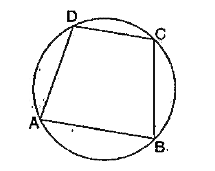If the sum of the diagonals of a rhombus is 12 cm, and its perimeter is 8√5 cm, then the lengths of the diagonals are :
6 cm and 6 cm
7 cm and 5 cm
8 cm and 4 cm
9 cm and 3 cm
The correct Answer is:C
To solve the problem, we need to find the lengths of the diagonals of a rhombus given that the sum of the diagonals is 12 cm and the perimeter is 8√5 cm.
1. Understanding the Properties of a Rhombus:
- Let the lengths of the diagonals be d1 and d2.
- According to the problem, we know that:
d1+d2=12(Equation 1)
2. Using the Perimeter of the Rhombus:
- The perimeter P of a rhombus can be expressed in terms of its diagonals as:
P=4×side length
- The side length s can also be calculated using the diagonals:
s=12√d21+d22
- Therefore, the perimeter can be rewritten as:
P=4×12√d21+d22=2√d21+d22
- Given that the perimeter is 8√5, we have:
2√d21+d22=8√5
- Dividing both sides by 2:
√d21+d22=4√5
- Squaring both sides gives us:
d21+d22=(4√5)2=16×5=80(Equation 2)
3. Substituting Equation 1 into Equation 2:
- From Equation 1, we can express d2 in terms of d1:
d2=12−d1
- Substituting this into Equation 2:
d21+(12−d1)2=80
- Expanding the equation:
d21+(144−24d1+d21)=80
- Combining like terms:
2d21−24d1+144=80
- Simplifying:
2d21−24d1+64=0
- Dividing the entire equation by 2:
d21−12d1+32=0(Quadratic Equation)
4. Solving the Quadratic Equation:
- We can use the quadratic formula d1=−b±√b2−4ac2a:
- Here, a=1, b=−12, and c=32.
- Calculating the discriminant:
b2−4ac=(−12)2−4×1×32=144−128=16
- Now substituting into the quadratic formula:
d1=12±√162=12±42
- This gives us two possible values:
d1=162=8andd1=82=4
5. Finding the Lengths of the Diagonals:
- If d1=8, then:
d2=12−8=4
- If d1=4, then:
d2=12−4=8
- Thus, the lengths of the diagonals are 8cm and 4cm.
Final Answer:
The lengths of the diagonals are 8cm and 4cm.
- Let the lengths of the diagonals be d1 and d2.
- According to the problem, we know that:
d1+d2=12(Equation 1)
- The perimeter P of a rhombus can be expressed in terms of its diagonals as:
P=4×side length
- The side length s can also be calculated using the diagonals:
s=12√d21+d22
- Therefore, the perimeter can be rewritten as:
P=4×12√d21+d22=2√d21+d22
- Given that the perimeter is 8√5, we have:
2√d21+d22=8√5
- Dividing both sides by 2:
√d21+d22=4√5
- Squaring both sides gives us:
d21+d22=(4√5)2=16×5=80(Equation 2)
- From Equation 1, we can express d2 in terms of d1:
d2=12−d1
- Substituting this into Equation 2:
d21+(12−d1)2=80
- Expanding the equation:
d21+(144−24d1+d21)=80
- Combining like terms:
2d21−24d1+144=80
- Simplifying:
2d21−24d1+64=0
- Dividing the entire equation by 2:
d21−12d1+32=0(Quadratic Equation)
- We can use the quadratic formula d1=−b±√b2−4ac2a:
- Here, a=1, b=−12, and c=32.
- Calculating the discriminant:
b2−4ac=(−12)2−4×1×32=144−128=16
- Now substituting into the quadratic formula:
d1=12±√162=12±42
- This gives us two possible values:
d1=162=8andd1=82=4
- If d1=8, then:
d2=12−8=4
- If d1=4, then:
d2=12−4=8
- Thus, the lengths of the diagonals are 8cm and 4cm.
The lengths of the diagonals are 8cm and 4cm.
Topper's Solved these Questions
- CIRCLES BOOK - S CHAND IIT JEE FOUNDATIONCHAPTER - CIRCLES EXERCISE - SELF ASSESSMENT SHEET
10 Videos
- AVERAGE BOOK - S CHAND IIT JEE FOUNDATIONCHAPTER - AVERAGE EXERCISE - UNIT TEST -3
20 Videos
- CIRCUMFERENCE AND AREA OF A CIRCLE BOOK - S CHAND IIT JEE FOUNDATIONCHAPTER - CIRCUMFERENCE AND AREA OF A CIRCLE EXERCISE - SELF ASSESSMENT SHEET - 22
10 Videos
Similar Questions
Which of the following statements is not TRUE ?

View SolutionSunil gets 10% more marks than Akbar .What percentage of marks does Akbar get less than Sunil ?
View SolutionA horse is tied to a pole fixed at one corner of a 50m×50m square field of grass by means of a 20 m long rope. What is the area to the nearest whole number of that part of the field which the horse can graze?
View Solutionएक समचतुर्भुज का परिमाप 40 सेमी. है यदि दोनों विकर्णों में से एक की लम्बाई 12 सेमी है तो दूसरे विकर्ण की लम्बाई क्या है?
View Solutionएक समचतुर्भुज का परिमाप 20 cm है तथा इसका एक विकर्ण 8 cm है। समचतुर्भुज का केत्रकल तथा दूसरे विकर्ण की लम्बाई ज्ञात करें।
View Solutionthe perimeter of a rhombus is 180 cm and one of its diagonals is 72 cm find the length of the other diagonal and the area of the Rhombus
View SolutionThe perimeter of a rhombus is 60 cm. If the length of its longer diagonal measures 24 cm, the length of the shorter diagonal is ........ cm.
View SolutionIf the diagonals of a rhombus are 12 cm and 5 cm, find the perimeter of the rhombus.
View Solutionएक समचतुर्भुज का परिमाप 20 सेमी तथा उसके एक विकर्ण की लम्बाई 8 सेमी हो, तो उसका क्षेत्रफल होगा-
View Solutionयदि एक समचतुर्भुज के विकर्ण 16 सेमी एवं 12 सेमी है, तो इसका परिमाप होगा
View Solutionयदि एक समचतुर्भुज के विकर्ण 16 सेमी 12 सेमी हैं , तो इसका परिमाप होगा
View Solutionएक समचतुर्भुज का परिमाप 104 सेमी है तथा इसके एक विकर्ण की लंबाई 48 सेमी है तो इसके दूसरे विकर्ण की लंबाई ज्ञात कीजिए।
View Solutionएक समचतुर्भुज के दो विकणों की लंबाई 6 सेमी. और 8 सेमी. है। इसका परिमाप (सेमी. में) ज्ञात करें।।
View SolutionIf the sum of diagonals of a rhombus is 10 cm and its area is 12cm2, then the lengths of its diagonals are :
View SolutionThe perimeter of a rhombus is 40 cm. If the length of one of its diagonals be 12 m, then the length of the other diagonal is
View Solution
